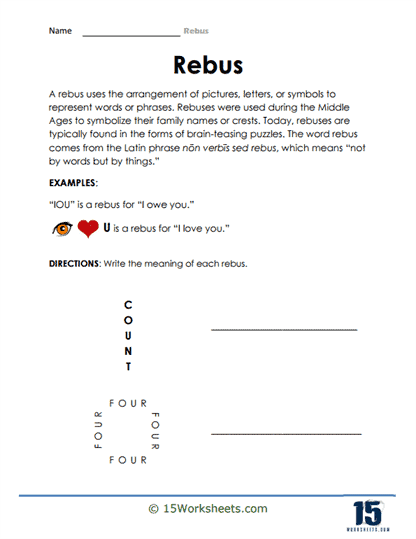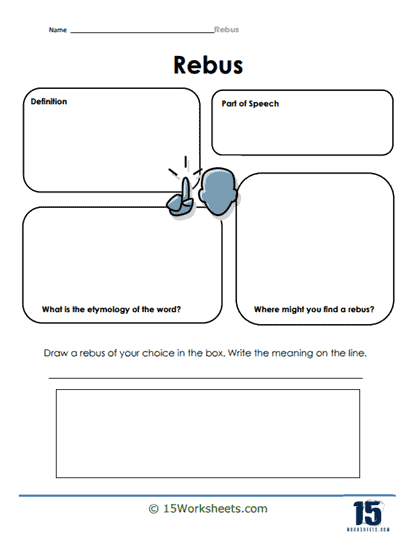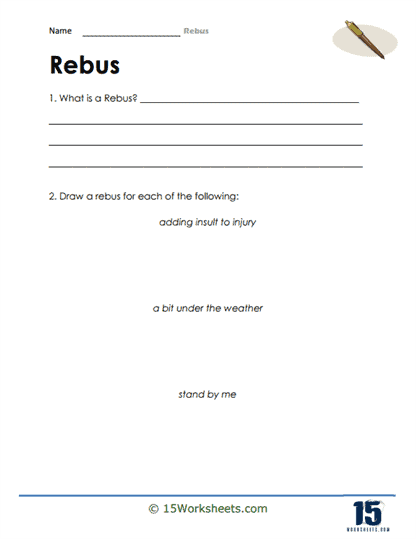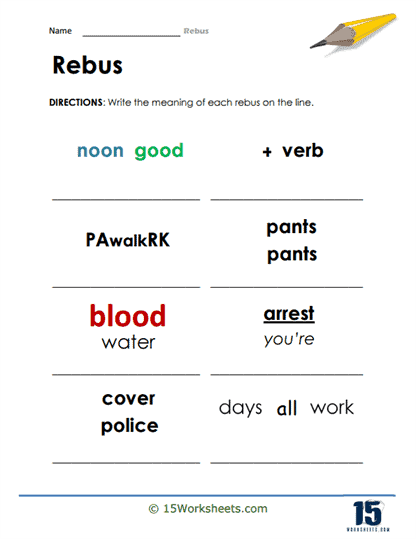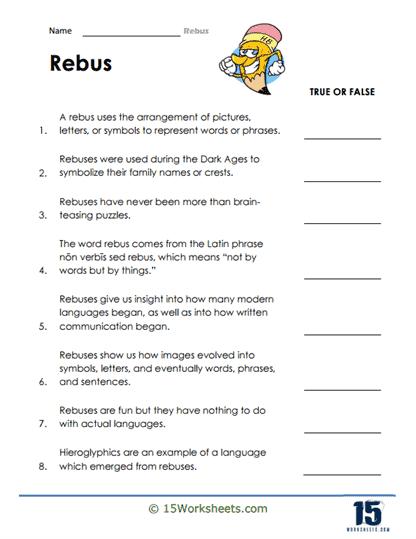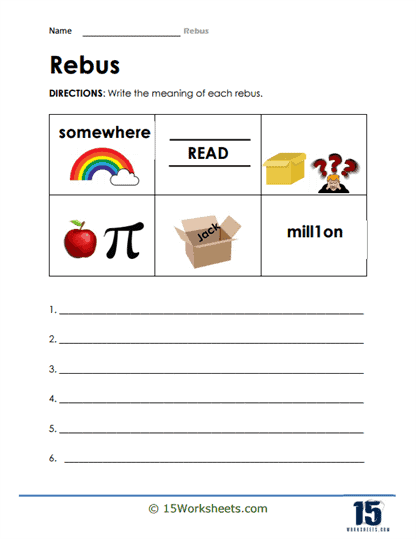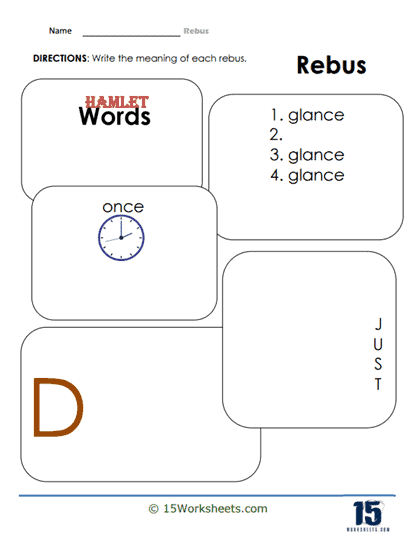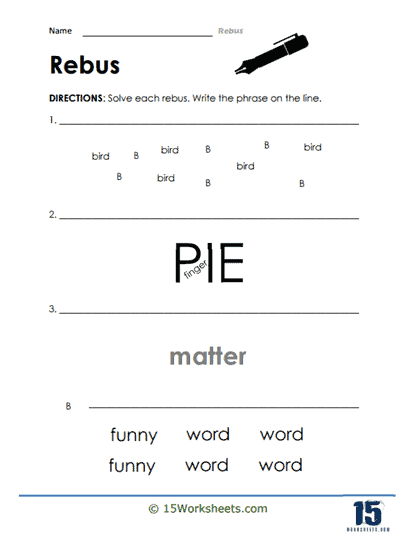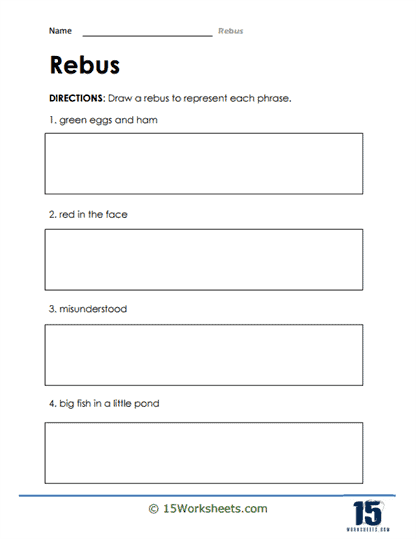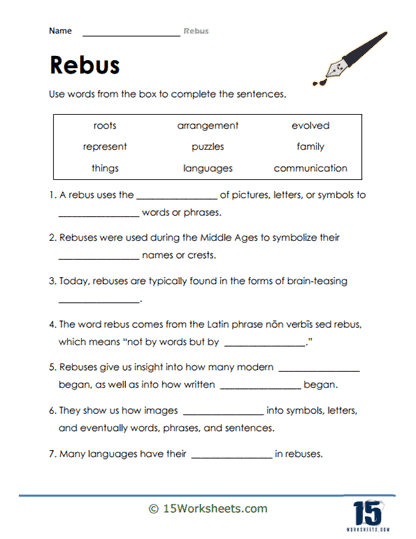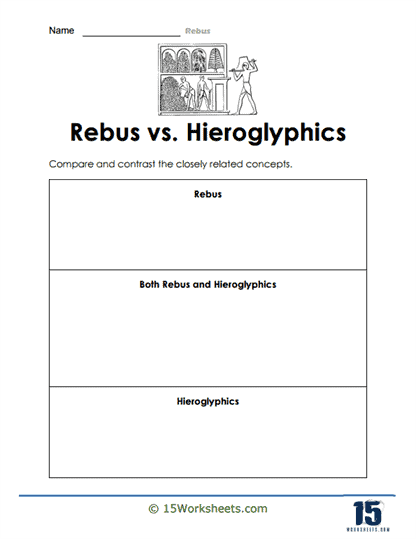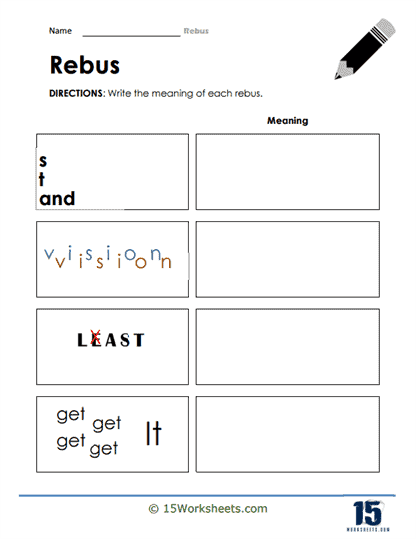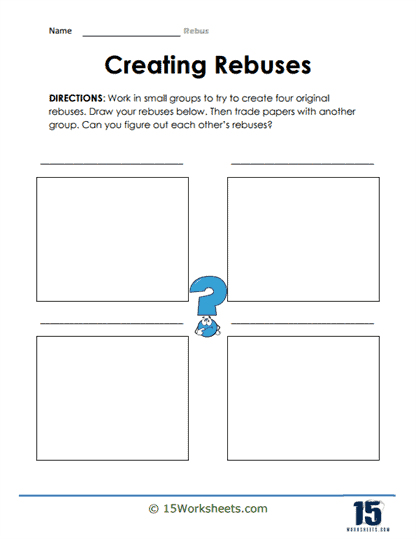Rebus Worksheets
All About These 15 Worksheets
A rebus, a word puzzle that uses pictures, symbols, or letters to represent words or parts of words, is a fun and engaging way to develop language skills, creative thinking, and problem-solving abilities.
Understanding rebuses is not only important for linguistic proficiency but also for fostering creativity, critical thinking, and a love for wordplay. This collection of 15 worksheets is designed to introduce students to the world of rebuses, helping them grasp the importance of this linguistic art form, recognize its various forms, and develop their own rebus-solving and puzzle-creating skills.
What Are Rebus Worksheets?
These worksheets are designed to introduce and practice the concept of a rebus in the literary sense. A rebus is a type of puzzle or riddle that uses pictures, symbols, or letters to represent words or parts of words. This device is used to stimulate thinking by encouraging the solver to associate sounds and spelling with symbols or pictures.
Here are some exercises you might expect to see on these worksheets:
Creation – This type of exercise would ask students to create their own rebus puzzles. For instance, they could be tasked with writing a sentence or phrase and then transforming it into a rebus puzzle using drawings or symbols.
Decoding – Students could be provided with a series of rebus puzzles and asked to decipher the meaning of each one. This activity will help reinforce their understanding of this device by applying it practically.
Interpretation – This might involve showing students a rebus and asking them to explain how it works. This is aimed at helping them understand the principle behind the rebus and how symbols and images can be used to represent words or parts of words.
Application in Writing – Students could be asked to incorporate rebus elements into a short story or paragraph. This can help students learn how to use this device creatively in their own writing.
These worksheets can be an exciting and engaging way to enhance a student’s critical thinking skills and creativity. They also provide an enjoyable way to bolster language arts lessons, especially vocabulary and writing exercises.
What is the Literary Device of Rebus?
A rebus is a puzzle or riddle that uses pictures, symbols, numbers, or letters to represent words or parts of words. The word “rebus” comes from the Latin phrase “Non verbis, sed rebus,” which means “Not by words, but by things.” Rebuses are considered a literary device because they use visuals to represent language.
Defining Features of a Rebus
The main defining feature of a rebus is its use of non-linguistic symbols to signify words or parts of words. These symbols can be pictures (like a cat to represent the word “cat”), letters or numbers (like “4” to represent “for”), or symbols (like “+” to represent “and”). Rebuses can range from simple representations, such as “I ♥ NY,” to more complex puzzles involving a combination of images and letters.
How Authors Use Rebus
Authors and creators use rebuses to engage readers in a unique way. By presenting words and phrases as puzzles to be solved, the reader becomes more actively involved in the text. This can make the reading experience more entertaining and memorable. Rebuses can also be used to convey complex ideas in a simpler, more visual way. They can also add an element of humor or playfulness to a text.
Examples of Rebus in Literature
Rebus Picture Books for Children
Many children’s books use rebuses to help young readers learn to associate words with images. One example is the “I Spy” series by Jean Marzollo and Walter Wick. In these books, rebuses are used to create riddles that the reader must solve by finding objects in a detailed photograph. For instance, the rebus might include a picture of an eye (for “I”), a spyglass (for “spy”), and a bee and a leaf (for “believe”). The reader would then have to find these items in the picture. By engaging the child’s problem-solving skills and linking words to images, these books make reading more interactive and enjoyable.
Rebus in Classic Literature
Rebuses have also been used in classic literature. One of the most famous examples is Lewis Carroll’s rebus letter to a young friend, which he included in “Alice’s Adventures Under Ground,” the original manuscript for “Alice’s Adventures in Wonderland.” The letter is written as a rebus puzzle, with pictures representing words or parts of words. For instance, Carroll uses a picture of a bee to represent the word “be,” and a picture of an ear to represent “ear” in “dear.” This playful letter serves as an example of Carroll’s love for word play and his skill in engaging his readers in imaginative ways.
Rebus in Modern Writing
Rebuses are not just for children’s books and classic literature—they also appear in modern writing. A contemporary example is the use of emoji in text messages and social media posts. Emoji function much like a rebus—they represent words or feelings with images. For instance, a text message might read, “I’m so 🍀 to have a friend like 👉🏽👈🏽,” using a clover to represent “lucky” and arrows to represent “you.” Although this might not be “literature” in the traditional sense, it demonstrates how the principle of the rebus is used in contemporary written communication.
Benefits Of Rebus Worksheets For Students
Exploring the world of rebuses through this collection of 15 brain-teasing worksheets offers students an opportunity to develop essential skills in language proficiency, critical thinking, creative expression, problem solving, and cultural and historical awareness. Rebuses are captivating puzzles that invite students to play with language and symbolism while honing their analytical and creative thinking.
By engaging with these exercises and activities, students not only enhance their academic abilities but also gain valuable tools for effective communication, linguistic creativity, and an understanding of the cultural and historical context of language and puzzles. The benefits of studying rebuses extend far beyond the classroom, empowering students to be more expressive, inventive, and culturally aware individuals in an increasingly complex and linguistic world.

